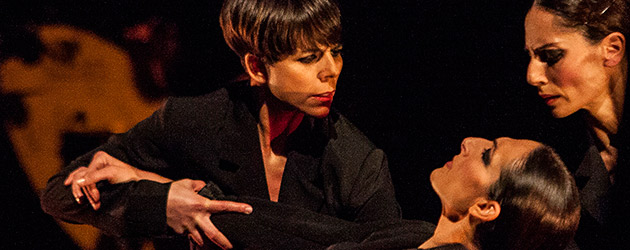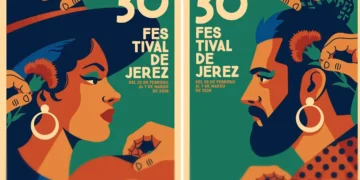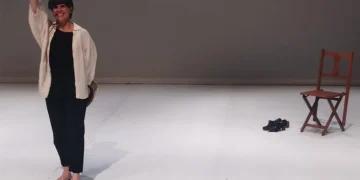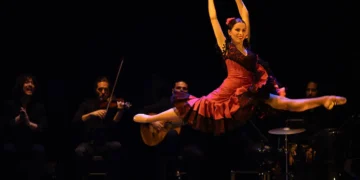Text: Silvia Cruz Lapeña
Photos: Ana Palma
Dance: Úrsula López, Tamara López, Leonor Leal. Flamenco guitar: Alfredo Lagos. Voice: Rosalía and Eva de Dios. Guitar: Antonio Duro. Proyecto Lorca: Juan M. Jiménez (saxofons) Antonio Moreno. Palmas: Melisa Soledad, Aniela. Choreography: Úrsula López, Tamara López, Leonor Leal, Mónica Valenciano, María Muñoz. Music: Alfredo Lagos. Aparatus: Pedro G. Romero.
Special 20 th Festival de Jerez – All the information
Anti-cliché sketches
Pedro G. Romero wanted to shake off the cliché image associated with Spain's painter Julio Romero de Torres. To get the job done, he found three female dancers, well-trained and professional. Tamara López, Úrsula López and Leonor Leal did a fine job with music that was cabaret style, chanson, tiptoeing through the jota and Spanish lyrical song, and of course, flamenco.
Six numbers that, more than scenes, were sketches, because period pieces were being given a work-over, and in order to achieve that, humor and irreverence were resorted to, and the nerve to «read» Romero de Torres from the twenty-first century. The idea delved into the role of women and female dancers, who were also actresses, and put in question the role of virgin, marionette and prostitute which history and the people who write it always ascribe to women. In this way, and to the music of saeta, the artists became Christs, rebels refusing to offer their bodies, even men who dance to the sound of a suite in which they bull-fight and challenge in a masculine way.
The voices of Eva de Dios and Rosalía, were much acclaimed. The former, because of her power and control. The young woman from Barcelona made an impression with her delicacy, adapting perfectly to the two musical treasures on stage: the guitars of Antonio Duro and Alfredo Lagos.
Úrsula wore a bata de cola for alegrías de Córdoba, and had the audience eating out of her hand. Tamara was better in her classical dance moments, and as actress, making use of her impressive body. The three danced well together and understood one another. And Leonor Leal again demonstrated her huge talent. What in other dancers would appear contrived, she makes look easy. The woman from Jerez was decisive. And so flamenco.
There were insinuations, at times obvious, of Proyecto Lorca, and videos were shown from museums that hold paintings of the Cordoban artist, images that would not have been missed had they been left out. The mix of sounds, aesthetics and origins with the work of J.R.T. as a back-drop, was hard for the audience to warm up to, but in the end, the level of dancing, guitar and singing was effusively applauded.
Descubre más desde Revista DeFlamenco.com
Suscríbete y recibe las últimas entradas en tu correo electrónico.



























